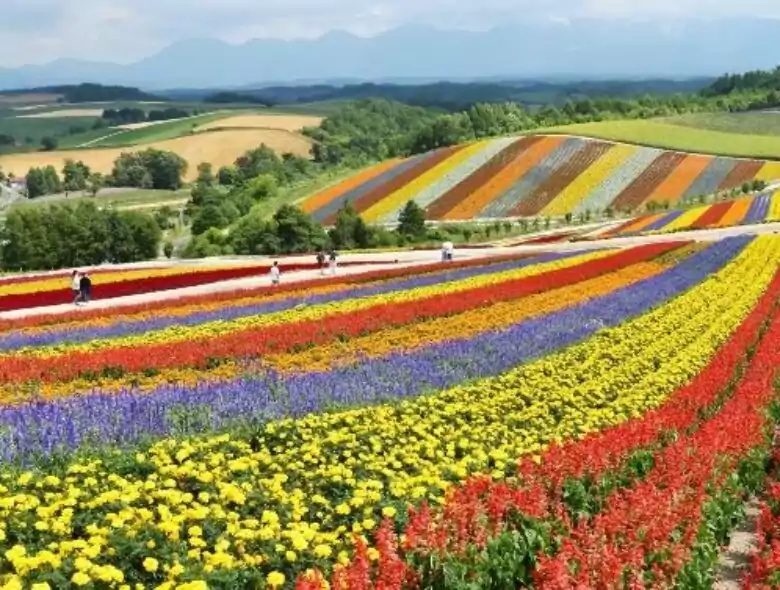Spring is finally here, and alongside the warmer weather, the ground comes alive with vivid colors from beautiful spring flowers. It is such a special time of the year, so we encourage you to make the most of it and step outside your apartment to spend some time appreciating nature!
Cherry blossoms are the symbol of spring. However, there are plenty of other spring flowers that are equally as beautiful. Below, we’re going to be discussing some of our other favorite Japanese spring flowers, so if you like flowers, nature, parks, and gardens, please read on!
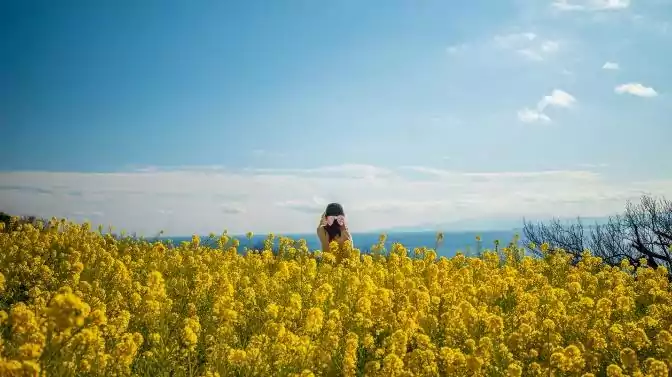
Rape Blossom (Nanohana)
Bright and bountiful flowers, rape blossom, also known as field mustard, are one of the late-winter early spring flowers in Japan. With beautiful yellow flowers and light green stems, rape blossom is an eye-catching sight.
You can find fields of rape blossom. The sight of the yellow flowers carpeting such a large expanse is beautiful, brightening the ground and signaling a sunny start to spring. It often lines the banks of rivers too. They bloom as early as March in Kyushu, and as late as May in Tohoku. They have a notably long flowering period of two to three months, so there are lots of opportunities to admire these flowers.
Sannokura Ski Resort in Fukushima is one of many places where you take in the gorgeous yellows of the rape blossom, with about 3.5 million flowers. If you’re living in Kyushu, Fukuoka’s Nokonoshima Park, on Nokonoshima island is a great spot to enjoy rape blossom flowers.
Rape blossom flowers, nanohana, are also a popular spring food, packed with nutrients that you can find at most supermarkets.
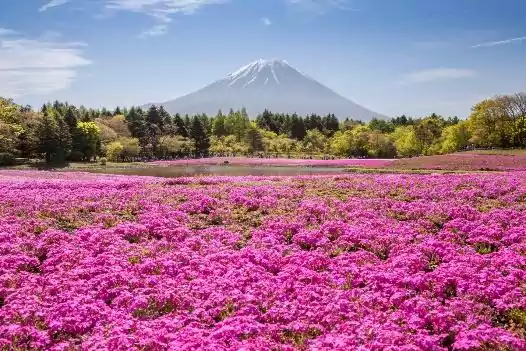
Moss Phlox (Shibazakura)
As beautiful and as pink as cherry blossoms, moss phlox flowers are a lesser-known bloom, great for anyone who wants to enjoy beautiful flowers without the crowds. These fuchsia-colored flowers bloom from April to June. They often appear in white and red colors as well.
Known as Shibazakura in Japanese, moss phlox is mesmerizing, particularly when viewed from a point of elevation or distance. This is because the ground becomes carpeted in layers of pink blooms.
One of the most iconic spots to view the moss phlox is the Fuji Shibazakura Festival held near Lake Motosuko. Here visitors can enjoy over 800,000 pink moss phlox flowers around the lake, with Mount Fuji standing majestically in the background.
Another beautiful place filled with moss phlox is the Higashimokoto Moss Pink Park in Ozora in Hokkaido prefecture. Chubachi Sueyoshi, created the whole park by himself to celebrate and honor the beautiful flower.
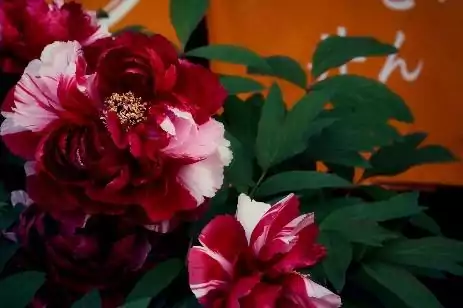
Peony (Botan)
Peonies are popular across the world for their peaceful and quiet symbolism. These stunning flowers are some of the largest spring blooms, coming in a variety of colors, mostly pinks, reds, and whites.
The spring peonies bloom from mid-April to mid-May. Some of the best spots for viewing these beautiful flowers are at the Chokokuji Temple Peony Festival on Sado island in Niigata. Here, you can attend a two-day festival celebrating the peony flowers, as well as enjoy other festivities such as a tea ceremony and traditional musical performances.
Hase Peony Festival in Nara is the best place for anyone in Kansai wanting to enjoy the flowers. Some of the peony trees at Hase Temple were planted more than 1000 years ago, so it’s a great spot for witnessing some of the most ancient peony trees in Japan. The festival offers tea ceremonies and kimono rentals too.
You can also find a special kind of winter-blooming peony in Japan. They tend to bloom from late November to early February. You can find the winter peonies at Hamarikyu Gardens or at Toshogu Shrine in Ueno Park, both in Tokyo.
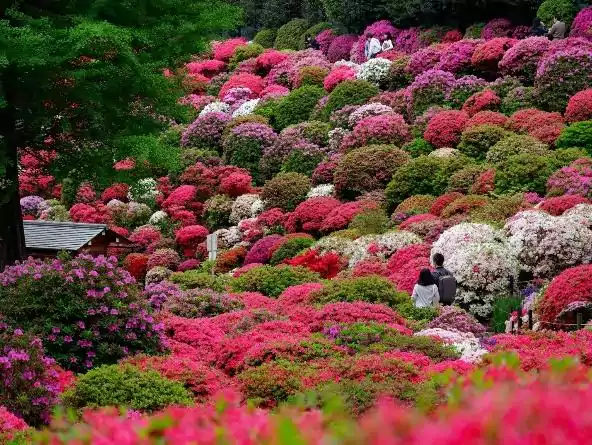
Azalea (Tsutsuji)
The end of the cherry blossoms is just the beginning of the rest of the year’s flowers. From April through to May, rhododendrons directly follow the Sakura season.
Known as Tsutsuji in Japan, azaleas, or rhododendrons, come in a variety of vibrant colors, including pinks, purples, whites, and reds. They symbolize patience and moderation. Azalea bushes can grow to large sizes and when in bloom, they turn from a vibrant leafy green to beautiful floral pinks.
Nezu Shrine in Tokyo is one of the most famous spots for taking in the sights of the tsutsuji. In the gardens, there are hundreds of enormous azalea bushes that are trimmed into round shapes that visitors can walk between. The bulbous shapes of the bushes make for a breathtaking scene where it feels almost like you are walking among clouds of flowers.
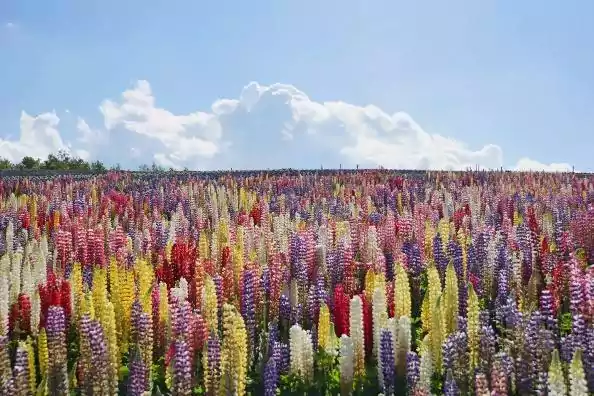
Lupine (Lupinasu)
Lupine flowers are some of the most striking flowers on this list. The long stems and unusual flowers stand out from a distance and look even more interesting up close. They look like wisteria flowers, but grow up from the ground, instead of draping from vines. Another Japanese name for lupine is “Nobori Fuji”, reflecting how similar they are to wisteria.
Lupine flowers usually come in shades of purples, blues, pinks, and whites. They bloom from around mid-April to early May. These plants are legumes but are also unfortunately poisonous.
They are often found in cooler and more mountainous areas, so the Tohoku and Hokkaido regions are some of the best places to view lupine flowers. Shinrin Park in Saitama prefecture is one of the popular places to view the lupine flowers. Similarly, Ashikaga Flower Park has plenty of beautiful lupine flowers, among other lovely blooms too.
One way to make sure you get to see all these flowers is by setting reminders in your calendar of when each flower is predicted to bloom – that way you don’t have to worry about missing out!
If you are currently looking for an apartment and consider moving near one of these beautiful flower spots, check out Village House, with over 1,000 properties in 47 prefectures throughout Japan. And for even more flowers to enjoy, please check out our guide on the best spots for Sakura viewing in Japan. Happy spring!
Related articles:
- Interior Design For Spring
- Spring Home Decor Ideas
- The Highlights of Spring in Japan
- The Spring Moving Season in Japan
- Sakura Snacks and Spring Themed Food in Japan


